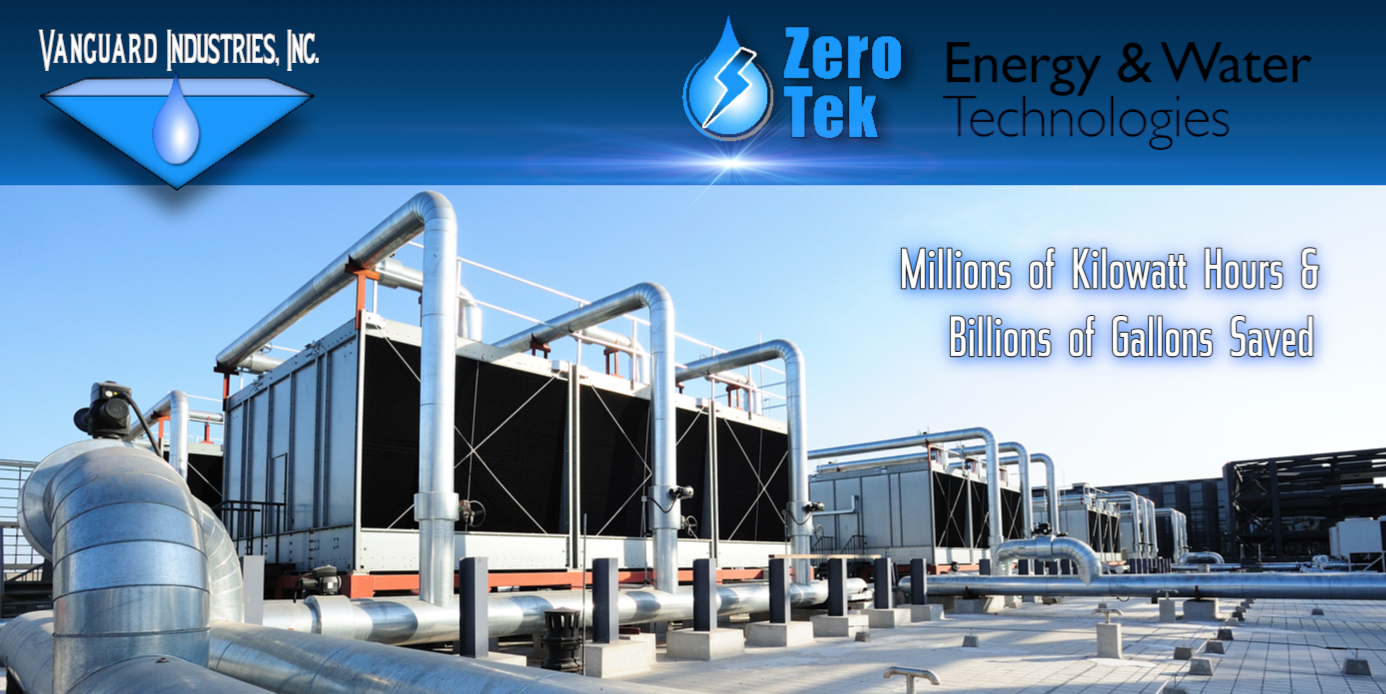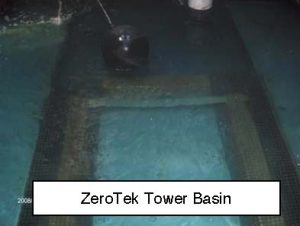“Green” – Low Environmental Impact Cooling Tower Water Management
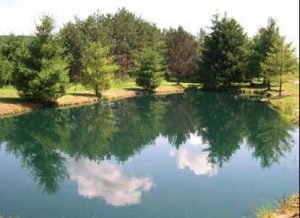 Cooling tower systems used for comfort cooling are usually the largest single water use in commercial and government buildings, accounting for up to 40% of the total facility water use. Accordingly, reducing the environmental impact of cooling tower system operation is a goal for every system owner/operator. Unfortunately as water treatment chemistry is a specialized field dealing in often proprietary technology, there is little reliable information with which the owner/operator can evaluate the various means to safely reduce environmental impact from operation of their cooling tower system. The following information on reducing the environmental impact of cooling tower system operation is based upon work in both the environmental and water treatment fields since 1973. Some basic technology is discussed along with new technologies developed specifically to reduce environmental impact while comments are provided on several misconceptions concerning water treatment chemistry, environmental impact, and the use of non chemical device (NCD) water treatment gadgets as a “green” technology. Blowdown – Intentional Water Loss from Cooling Systems Evaporative cooling tower systems reject 75 to 80% of their heat load by evaporation of water. As the water evaporates, removing heat from the system, the dissolved solids present in makeup water, added to replace the evaporated water, become more concentrated, at some point exceeding the solubility limit(s) of the materials present (usually calcium carbonate) which results in precipitation and formation of undesirable scale. Blowdown is water intentionally drained from the system to restrict the buildup of dissolved solids to levels below the precipitation point. Cycles of concentration (COC) is the term used to denote the dissolved solids concentration in the system water as compared to the makeup water, thus at two (2) COC the dissolved solids in the system water are twice the level in the makeup water. Blowdown constitutes a major environmental impact from cooling tower system operation as it is “wasted” water, water run to sewer that must be replaced with fresh water. For instance, a 1000 ton thermal load cooling tower running at two (2) COC will evaporate 26,600 gpd with a blowdown of 26,600 gpd. Evaporation = 26.6 gpd/ton cooling load Blowdown = Evaporation/COC – 1 Since increasing COC generally results in solubility limits being quickly exceeded, acid or a scale inhibitor must be added to the cycled cooling water to prevent scale formation. In practice, acid is not recommended due to health/safety and control issues, while use of scale inhibiting products generally limits the system to a maximum of five (5) COC. Using the 1000 ton system example, operation at five (5) COC with chemical scale inhibitors would reduce the blowdown to 6,650 gpd. Due to technical challenges, standard water management programs are generally operated at no more than five (5) COC, and often times less.
Cooling tower systems used for comfort cooling are usually the largest single water use in commercial and government buildings, accounting for up to 40% of the total facility water use. Accordingly, reducing the environmental impact of cooling tower system operation is a goal for every system owner/operator. Unfortunately as water treatment chemistry is a specialized field dealing in often proprietary technology, there is little reliable information with which the owner/operator can evaluate the various means to safely reduce environmental impact from operation of their cooling tower system. The following information on reducing the environmental impact of cooling tower system operation is based upon work in both the environmental and water treatment fields since 1973. Some basic technology is discussed along with new technologies developed specifically to reduce environmental impact while comments are provided on several misconceptions concerning water treatment chemistry, environmental impact, and the use of non chemical device (NCD) water treatment gadgets as a “green” technology. Blowdown – Intentional Water Loss from Cooling Systems Evaporative cooling tower systems reject 75 to 80% of their heat load by evaporation of water. As the water evaporates, removing heat from the system, the dissolved solids present in makeup water, added to replace the evaporated water, become more concentrated, at some point exceeding the solubility limit(s) of the materials present (usually calcium carbonate) which results in precipitation and formation of undesirable scale. Blowdown is water intentionally drained from the system to restrict the buildup of dissolved solids to levels below the precipitation point. Cycles of concentration (COC) is the term used to denote the dissolved solids concentration in the system water as compared to the makeup water, thus at two (2) COC the dissolved solids in the system water are twice the level in the makeup water. Blowdown constitutes a major environmental impact from cooling tower system operation as it is “wasted” water, water run to sewer that must be replaced with fresh water. For instance, a 1000 ton thermal load cooling tower running at two (2) COC will evaporate 26,600 gpd with a blowdown of 26,600 gpd. Evaporation = 26.6 gpd/ton cooling load Blowdown = Evaporation/COC – 1 Since increasing COC generally results in solubility limits being quickly exceeded, acid or a scale inhibitor must be added to the cycled cooling water to prevent scale formation. In practice, acid is not recommended due to health/safety and control issues, while use of scale inhibiting products generally limits the system to a maximum of five (5) COC. Using the 1000 ton system example, operation at five (5) COC with chemical scale inhibitors would reduce the blowdown to 6,650 gpd. Due to technical challenges, standard water management programs are generally operated at no more than five (5) COC, and often times less.
Chemical Scale Inhibitor Use
A common misconception is that it is “bad” for the environment to be adding “chemicals” to cooling water. Fortunately, this is incorrect as the truth of the matter is that the effective, commonly used scale inhibitor compounds have very low toxicities and are completely biodegraded when discharged into the environment. Thus use of scale inhibitor products in cooling towers does not adversely impact the environment. In fact, when used to increase COC, scale inhibitor chemical use reduces the environmental impact of system operation by lowering the amount of fresh water used and blowdown discharged. A second environmental benefit, often very substantial, is that by keeping the heat exchange surfaces in the system free of scale, energy use, and resultant environmental pollution from energy production, is reduced. For instance, a scale thickness of just 0.08 inches can increase energy usage in a chiller condenser by as much as 12%, a waste that can be totally prevented by proper use of scale inhibitor chemicals. Reduced and Zero Blowdown Operation
While it does present some serious technical problems related to corrosion and deposition, a substantial number of cooling towers are now routinely operated above eight (8) COC using totally softened makeup water. Removing the major scale formers, calcium and magnesium, by softening renders the water non-scaling for cooling tower operation and COC is thus limited only by deposition related problems. The corrosion problem resulting from operation with highly corrosive, cycled softened water has been solved by development of specific soft water corrosion control chemistry. Use of our ZeroTek water management program, allows tower operation at substantially reduced blowdown rates obtained by high COC operation without acid feed and with no possibility of scale formation. Looking at a 1000 ton thermal load system with operation at 10 COC, the blowdown rate has been reduced to just 2,956 gpd. High cycles system operation can be obtained by increasing the COC to the point where windage, liquid water carried out of the cooling tower by the passage of air through the unit, equals the blowdown at that COC. When windage equals blowdown, the cooling tower is operating with zero blowdown. Typically, we see that zero blowdown occurs between 12 and 25 COC, dependent upon cooling tower design, state of maintenance, and flow rate (load). An additional problem, deposition from airborne debris and products of corrosion, must be addressed for reliable zero blowdown operation. We have found that use of a multimedia filter, or cartridge filter in smaller cooling systems, combined with the ZeroTek chemistry developed for soft water makeup operation is effective in controlling deposition in a zero blowdown cooling tower system. Please note that the specific process and chemical technology employed by ZeroTek management program is patented, US Patent #7,595,000. Reduced and zero blowdown operation of cooling tower systems can be used to obtain USGBC LEED credits for reduced water usage and/or innovative technology use.
Biological Control – Biocide Dangers
Warm cooling water is an excellent place to grow microorganisms, including pathogens such as legionella. This growth causes severe system problems related to risk of Legionnaires’ Disease, system plugging, accelerated corrosion, and reduced heat exchanger efficiency. Typically, microorganism growth in systems is controlled by routine addition of toxic chemicals, biocides, to the system, which kill the microorganisms. Annually, millions of pounds of toxic biocides are used in cooling towers, creating a potential for transportation and usage spills, in hundreds of thousands of cooling tower systems located in our towns and neighborhoods. Following addition, biocides are subsequently discharged in the blowdown to the public sewers, thus reaching our streams and lakes. The use of biocides in cooling towers thus constitutes the major environmental impact from cooling system operation due to potential damage from accidental spills and routine discharge of toxics in blowdown. Toxic biocide use is also a substantial health/safety issue for all the workers involved in the handling/use of such products. Many microorganism control technologies are presently marketed as “green”. These methods, such as copper-silver ionization, ozone, and the various NCD gadgets; either have a substantial environmental impact 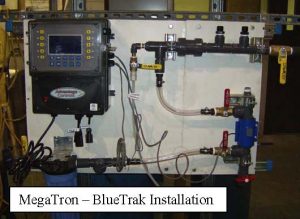 themselves (copper and silver ions discharged in the blowdown!), present major health and safety problems (ozone requires high voltage electrical generation and ozone is toxic), or just do not work (do any of the NCD gadgets have a USEPA registration number?). The best means to eliminate the impact of biocide use in cooling tower systems is the patent pending electrolytic bromine biocide technology developed by ProChemTech. This unique technology generates a non-hazardous aqueous solution of electrolytic bromine on-site by electrolysis of either an aqueous table salt and sodium bromide brine solution, or a cooling water side stream in a system operated with a ZeroTek or HCT water management program. After addition to the cooling system, the generated electrolytic bromine reverts back to the starting non-toxic bromide ion (present in sea water at 65 mg/l) in a short time, thus eliminating discharge of any toxics in the blowdown. This economical technology thus eliminates both the environmental impact from controlling biological growth in systems and worker health/safety issues from handling of toxic biocides. Units are available for systems from small HVAC installations to power plants. Corrosion Control Most cooling water systems have substantial amounts of metal, such as copper and zinc, used in their construction. Uncontrolled corrosion of these metals will not only destroy the cooling water system over time, but will also have an adverse effect on the environment by discharge of these metals via system blowdown. While some corrosion inhibitors, such as molybdate and phosphate, can have an adverse environmental impact, controlling corrosion within systems is a decided benefit to the overall ecosystem due to reduced metals discharge to the environment and avoidance of the environmental impact resulting from premature replacement of corrosion damaged systems.
themselves (copper and silver ions discharged in the blowdown!), present major health and safety problems (ozone requires high voltage electrical generation and ozone is toxic), or just do not work (do any of the NCD gadgets have a USEPA registration number?). The best means to eliminate the impact of biocide use in cooling tower systems is the patent pending electrolytic bromine biocide technology developed by ProChemTech. This unique technology generates a non-hazardous aqueous solution of electrolytic bromine on-site by electrolysis of either an aqueous table salt and sodium bromide brine solution, or a cooling water side stream in a system operated with a ZeroTek or HCT water management program. After addition to the cooling system, the generated electrolytic bromine reverts back to the starting non-toxic bromide ion (present in sea water at 65 mg/l) in a short time, thus eliminating discharge of any toxics in the blowdown. This economical technology thus eliminates both the environmental impact from controlling biological growth in systems and worker health/safety issues from handling of toxic biocides. Units are available for systems from small HVAC installations to power plants. Corrosion Control Most cooling water systems have substantial amounts of metal, such as copper and zinc, used in their construction. Uncontrolled corrosion of these metals will not only destroy the cooling water system over time, but will also have an adverse effect on the environment by discharge of these metals via system blowdown. While some corrosion inhibitors, such as molybdate and phosphate, can have an adverse environmental impact, controlling corrosion within systems is a decided benefit to the overall ecosystem due to reduced metals discharge to the environment and avoidance of the environmental impact resulting from premature replacement of corrosion damaged systems.
 themselves (copper and silver ions discharged in the blowdown!), present major health and safety problems (ozone requires high voltage electrical generation and ozone is toxic), or just do not work (do any of the NCD gadgets have a USEPA registration number?). The best means to eliminate the impact of biocide use in cooling tower systems is the patent pending electrolytic bromine biocide technology developed by ProChemTech. This unique technology generates a non-hazardous aqueous solution of electrolytic bromine on-site by electrolysis of either an aqueous table salt and sodium bromide brine solution, or a cooling water side stream in a system operated with a ZeroTek or HCT water management program. After addition to the cooling system, the generated electrolytic bromine reverts back to the starting non-toxic bromide ion (present in sea water at 65 mg/l) in a short time, thus eliminating discharge of any toxics in the blowdown. This economical technology thus eliminates both the environmental impact from controlling biological growth in systems and worker health/safety issues from handling of toxic biocides. Units are available for systems from small HVAC installations to power plants. Corrosion Control Most cooling water systems have substantial amounts of metal, such as copper and zinc, used in their construction. Uncontrolled corrosion of these metals will not only destroy the cooling water system over time, but will also have an adverse effect on the environment by discharge of these metals via system blowdown. While some corrosion inhibitors, such as molybdate and phosphate, can have an adverse environmental impact, controlling corrosion within systems is a decided benefit to the overall ecosystem due to reduced metals discharge to the environment and avoidance of the environmental impact resulting from premature replacement of corrosion damaged systems.
themselves (copper and silver ions discharged in the blowdown!), present major health and safety problems (ozone requires high voltage electrical generation and ozone is toxic), or just do not work (do any of the NCD gadgets have a USEPA registration number?). The best means to eliminate the impact of biocide use in cooling tower systems is the patent pending electrolytic bromine biocide technology developed by ProChemTech. This unique technology generates a non-hazardous aqueous solution of electrolytic bromine on-site by electrolysis of either an aqueous table salt and sodium bromide brine solution, or a cooling water side stream in a system operated with a ZeroTek or HCT water management program. After addition to the cooling system, the generated electrolytic bromine reverts back to the starting non-toxic bromide ion (present in sea water at 65 mg/l) in a short time, thus eliminating discharge of any toxics in the blowdown. This economical technology thus eliminates both the environmental impact from controlling biological growth in systems and worker health/safety issues from handling of toxic biocides. Units are available for systems from small HVAC installations to power plants. Corrosion Control Most cooling water systems have substantial amounts of metal, such as copper and zinc, used in their construction. Uncontrolled corrosion of these metals will not only destroy the cooling water system over time, but will also have an adverse effect on the environment by discharge of these metals via system blowdown. While some corrosion inhibitors, such as molybdate and phosphate, can have an adverse environmental impact, controlling corrosion within systems is a decided benefit to the overall ecosystem due to reduced metals discharge to the environment and avoidance of the environmental impact resulting from premature replacement of corrosion damaged systems.
Electrolytic Bromine Unit
If proper care is taken during selection of corrosion control chemistry to account for the environmental impact of the specific products selected, water management programs can be easily designed which have no adverse environmental impact. Given the vast number of products available to the water treatment chemist today, such a program, inclusive of ZeroTek and HCT, can be designed which will keep corrosion rates below 2 mil/yr st
eel and 0.1 mil/yr yellow metals. Scale and corrosion inhibitor dosage to systems should be carefully controlled to prevent any adverse environmental effects from over or under dosing, provide for optimum performance, and control the program cost. A cost effective means to control dosage is generally referred to as proportional control, which is simply the process where the amount of makeup water added to the system is metered and the inhibitor products are fed in direct proportion using chemical pumps drawing directly from product shipping containers. Recent development of absorbance tracer technology commercialized as Blue Trace and BlueTrak has improved both the precision and accuracy of control testing and eliminated the use of hazardous test reagents. The is improvement in control testing allows lower levels of chemical scale and corrosion inhibitors to be used effectively, reducing any potential enviromental impact. BlueTrak is an automated, spectrophotometer based on-line monitor that allows even closer chemical dosage control that the proportional method and thus lower chemical usage.
“Green” Gadgets
In the past fifty years a substantial number of NCD gadgets for treatment of cooling water have been marketed. These gadgets claim to control scale, corrosion, deposition, and biological growth in systems by a variety of processes described as magnetic, electrostatic, hydrodynamic, pulsed power, electromagnetic induction, ionization, and zeta potential; among others. Numerous objective studies by various government agencies and industrial firms over the years have shown all of these gadgets to be of no practical use in water treatment. Review of recent marketing literature by firms such as Clearwater LLC, the “Dolphin” unit, and TLC Envirotech, Inc., show that such gadgets are now being marketed as a “green” technology since they use no chemicals. Careful review of gadget literature shows that operation is not based upon any accepted scientific principals while the only evidence offered to substantiate acceptable performance is in the form of testimonials. In every case where a testimonial has been subjected to scientific investigation, the performance reported was found to be due to cause(s) other than the gadget. For example, in many cases scientific investigation has shown that the cooling system cycles had been reduced by a substantial amount following installation of the gadget. Operating at lower cycles often reduces dissolved solids to the point where precipitation will not occur, thus “controlling” previous scale formation and sometimes removing any existing scale. Of course, operating at lower cycles increases blowdown to the sewer and fresh makeup water requirements, hardly a “green” treatment technology.
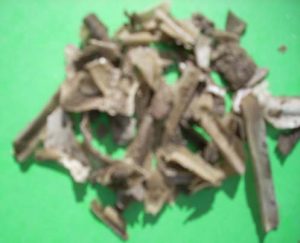 MegaTron – BlueTrak Installation
MegaTron – BlueTrak InstallationAnother observation often made in systems reporting successful operation with gadgets is that they are excessively cycled to the point where bulk precipitation of calcium carbonate is taking place in the system water. While this will often protect high flow heat exchanger surfaces from formation of scale, reduce planktonic microbiological activity, and will produce a very clear water due to flocculation precipitation: the scale solids will build up somewhere in the system and at some point require removal. This phenomenon is a known chemistry and has been used in both potable and boiler water treatment for over one hundred years. It is difficult to control in cooling system applications and will not work in high heat flux industrial applications, which are the reasons it is not used by reputable water management firms. Considering on a rational basis the potential for adverse environmental impact from premature failure and replacement of systems from corrosion, excessive blowdown, and excessive energy use due to scale/deposition; replacement of proven “green” water management practices with a NCD gadget cannot be considered “green” technology. In reality, use of NCD gadgets results in increased environmental impact due to increased water usage, increased blowdown discharge, increased corrosion and discharge of metals, and additional pollution due to increased energy usage caused by scale formation on heat exchange surfaces. It should also be noted that any gadget being marketed as capable of providing biological control within a system must be, under law, registered with the USEPA as a pesticide. To date, no gadgets have obtained such registration.
Prepared by: Timothy Keister, CWT FAIC
Reference Material:
– “Cooling Water Treatment, Principles and Practice”, Colin Frayne, Chemical Publishing Company, New York, NY, 1999
– “The Chemical Treatment of Cooling Water”, James W. McCoy, Chemical Publishing Company, New York, NY, 1983
– “Non-Chemical Devices: Thirty Years of Myth Busting”, International Water Conference, Keister, 2004
– “Demonstration and Evaluation of Magnetic Descalers”, US Army Corps of Engineers,
Construction Engineering Research Laboratory, 2001, ERDC/CERL TR-01-63
Please contact:
Vanguard Industries Inc.
“Performance, Not Promises”
www.vanguardfl.com/
407.808.8236
